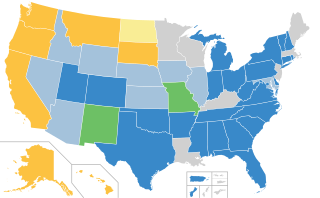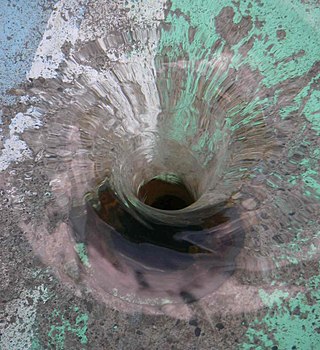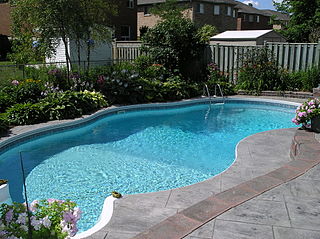Related Research Articles

Plumbing is any system that conveys fluids for a wide range of applications. Plumbing uses pipes, valves, plumbing fixtures, tanks, and other apparatuses to convey fluids. Heating and cooling (HVAC), waste removal, and potable water delivery are among the most common uses for plumbing, but it is not limited to these applications. The word derives from the Latin for lead, plumbum, as the first effective pipes used in the Roman era were lead pipes.

A building code is a set of rules that specify the standards for construction objects such as buildings and non-building structures. Buildings must conform to the code to obtain planning permission, usually from a local council. The main purpose of building codes is to protect public health, safety and general welfare as they relate to the construction and occupancy of buildings and structures — for example, the building codes in many countries require engineers to consider the effects of soil liquefaction in the design of new buildings. The building code becomes law of a particular jurisdiction when formally enacted by the appropriate governmental or private authority.

A hot tub is a large tub full of water used for hydrotherapy, relaxation or pleasure. Some have powerful jets for massage purposes. Hot tubs are sometimes also known as "spas" or by the trade name Jacuzzi. Hot tubs may be located outdoors or indoors.
A swimming machine, also known as a resistance swimming apparatus, is a self-contained device powered by a pump, designed to facilitate stationary swimming for athletes or recreational users. This can be achieved by either propelling water past the swimmer or providing support for the swimmer, either within a water environment or on dry land.

Landscape lighting or garden lighting refers to the use of outdoor illumination of private gardens and public landscapes; for the enhancement and purposes of safety, nighttime aesthetics, accessibility, security, recreation and sports, and social and event uses.

Designated as an American National Standard, the Uniform Plumbing Code (UPC) is a model code developed by the International Association of Plumbing and Mechanical Officials (IAPMO) to govern the installation and inspection of plumbing systems as a means of promoting the public's health, safety and welfare.

An automated pool cleaner is a vacuum cleaner that is designed to collect debris and sediment from swimming pools with minimal human intervention.
Building officials of developed countries are generally the jurisdictional administrator of building and construction codes, engineering calculation supervision, permits, facilities management, and accepted construction procedures.

A swimming pool fence is a type of fence placed around swimming pools, to create a passive barrier to restrict the access of small children to the swimming pool. Swimming pool fences must have a self-closing and self-latching gate/s to be compliant to most countries' laws and codes.

A drain is the primary vessel or conduit for unwanted water or waste liquids to flow away, either to a more useful area, funnelled into a receptacle, or run into sewers or stormwater mains as waste discharge to be released or processed.

A swimming pool service technician is a person who maintains swimming pools, including keeping the water clean and safe by fixing pool equipment such as pumps, motors and water filters.
Uniform Codes are codes of practice developed and maintained by the International Association of Plumbing and Mechanical Officials (IAPMO) using the American National Standards Institute's (ANSI) accredited consensus development process working on a three-year cycle. This process brings together volunteers representing a variety of viewpoints and interests to achieve consensus.

A swimming pool, swimming bath, wading pool, paddling pool, or simply pool, is a structure designed to hold water to enable swimming or other leisure activities. Pools can be built into the ground or built above ground, and may be found as a feature aboard ocean-liners and cruise ships. In-ground pools are most commonly constructed from materials such as concrete, natural stone, metal, plastic, composite or fiberglass, and can be of a custom size and shape or built to a standardized size, the largest of which is the Olympic-size swimming pool.
The Virginia Graeme Baker Pool and Spa Safety Act (VGBA) is a United States law named after Virginia Graeme Baker, who died after sustaining a pool suction-drain injury in June 2002, when the suction from a spa drain entrapped her under the water. It is incorporated as Title 14 of the U.S. Energy Independence and Security Act of 2007. This act became enforceable law on December 19, 2008.
IAPMO Standards are the plumbing and mechanical standards of the International Association of Plumbing and Mechanical Officials (IAPMO). For more than thirty years, IAPMO’s standards-developing efforts have primarily focused on plumbing product standards. This concentration was primarily due to IAPMO members’ expertise from more than 50 years of writing and updating the Uniform Plumbing Code (UPC). IAPMO is an American National Standards Institute (ANSI)-recognized Standards Development Organization (SDO).
IAPMO R&T was started in 1936 as a third-party listing agency specializing in plumbing and mechanical products. IAPMO R&T is accredited to certify products that meet the criteria of the Uniform Plumbing Code, Uniform Mechanical Code, Uniform Solar Energy Code, Uniform Swimming Pool, Spa and Hot Tub Code and other nationally recognized codes and standards in North America.
A plumbing code is a code that provides regulations for the design, installation and inspection of building plumbing and sanitary systems. In the United States, jurisdictions enact their own codes, some of which are based upon model plumbing codes. The most widely adopted plumbing code in the United States is the International Plumbing Code published by the International Code Council (ICC). This code is also used as the basis for the plumbing codes of some other countries. Another model plumbing code published and utilized widely across the United States is the Uniform Plumbing Code, published by the International Association of Plumbing and Mechanical Officials (IAPMO), a multinational operation with offices in 13 nations. IAPMO codes are developed using ANSI consensus development procedures. This code serves as the basis for the national plumbing codes in India and Indonesia.
The International Association of Plumbing and Mechanical Officials (IAPMO) coordinates the development and adaptation of plumbing, mechanical, swimming pool and solar energy codes to meet the specific needs of individual jurisdictions both in the United States and abroad.
The Uniform Mechanical Code (UMC) is a model code developed by the International Association of Plumbing and Mechanical Officials (IAPMO) to govern the installation, inspection and maintenance of HVAC and refrigeration systems. It is designated as an American National Standard.
Designated as an American National Standard, the Uniform Solar, Hydronics and Geothermal Code (USHGC) is a model code developed by the International Association of Plumbing and Mechanical Officials (IAPMO) to govern the installation and inspection of solar energy, hydronic heating/cooling systems, and geothermal energy systems as a means of promoting the public's health, safety and welfare.
References
- ↑ Unknown
- ↑ "IAPMO Releases Report on Comments Books for 2012 Uniform Swimming Pool, Spa and Hot Tub Code and 2012 Uniform Solar Energy Code". IAPMO Online. 2012-02-09. Retrieved 2022-11-04.
- ↑ "StackPath". StackPath. 25 April 2012. Retrieved 2022-11-04.